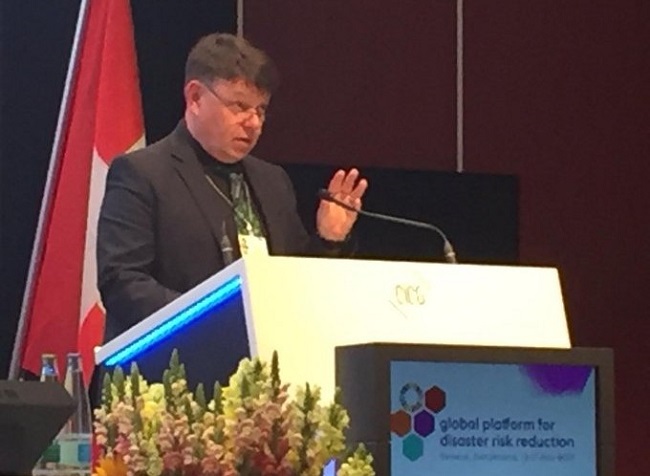The impacts of climate change, associated sea level rise and extreme weather are amplifying as a result of record greenhouse gas levels and combining with urbanisation, environmental degradation and water stress to produce interlocking crises. There needs to be a drastic change of course, according to the top global forum on disaster risk reduction.

“We live with the highest concentration of carbon dioxide in the atmosphere for three million years,” World Meteorological Organisation (WMO) Secretary-General, Petteri Taalas, told the Global Platform for Disaster Risk Reduction. The four warmest years on record have been in the past four years and the warming trend which has lasted since the start of this century is expected to continue as a result of the increase in greenhouse gas levels. Climate change mitigation is essential, as is climate change adaptation, he stressed.
“Last year, in the United States alone, there were 14 weather- and climate-related disasters where the devastation cost more than $1 billion each, with a total of some $49 billion. Worldwide, more than 35 million people were affected by floods. This year, tropical cyclone Idai left more than 1,000 people dead in Mozambique, Zimbabwe, and Malawi, and only a few weeks later tropical cyclone Kenneth was the strongest tropical cyclone to make landfall and strike the furthest north in Mozambique since modern records began,” said Mr Taalas.
“The 2019 Global Platform for Disaster Risk Reduction” focuses on accelerating action to boost resilience against interlocking natural hazards that disrupt or destroy the lives of millions of people every year. The platform is organised biennially by the UN Office for Disaster Risk Reduction and took place from May 13 to 17.
Mr Taalas also delivered a joint statement on behalf of the UN system, declaring the need to “make a drastic change of course,” in order to tackle global crises.
“We do not have time to lose. As the UN Secretary-General has pointed out, ‘Climate change is moving faster than we are’. Urbanisation and industrialisation, water scarcity, land degradation and desertification, and biodiversity loss are some of the many inter-linked drivers of increasing disaster and climate change impacts. The most vulnerable countries and peoples are already facing the devastating impacts. As we have witnessed in Mozambique, India, East Africa and many other countries and regions around the world in the past years, climate and disaster risk is pushing millions of people back into poverty each year. Millions are displaced. Many are being left behind,” said the joint statement.
“We need to step up efforts to manage existing risks that have built up over time, while preventing as much as possible future risks from being created,” said the statement.
The global platform aims to accelerate progress towards the key targets of the “Sendai Framework for Disaster Risk Reduction 2015-2030”, the global plan to reduce disaster losses adopted by the international community in March 2015.
“If I had to select one sentence to describe the state of the world, I would say we are in a world in which global challenges are more and more integrated, and the responses are more and more fragmented, and if this is not reversed, it’s a recipe for disaster,” UN Secretary-General António Guterres commented in the “Global Assessment Report” 2019, published to coincide with the global platform.
The Global Platform aims to review progress, share knowledge and discuss the latest developments and trends in reducing disaster risk.
Multi-hazard early warning conference
The outcome of the Second Multi-Hazard Early Warning Conference (MHEWC-II), hosted by WMO, fed into the global platform discussions. The meeting on May 13 to 14 was organised by the 19 partners of the International Network for Multi-Hazard Early Warning Systems (IN-MHEWS) and additional organisations.
The conference focused on improved warnings – and improved action – in the face of hazards like earthquakes, volcanic eruptions, extreme weather, water and climate events and the interlocking challenges of climate change, population increase, urbanisation and environmental degradation.
“From WMO’s perspective, we see that the engine of disaster risk reduction are the early warning systems. Disaster risk reduction is like a car and early warning systems are the engine,” Mr Taalas said.
Just as the engine needs to propel the car to the last mile, and the last metre, it is essential that early warnings reach those who need them most, the Second Multi-Hazard Early Warning Conference heard.
The conference discussed success stories, but also challenges.
